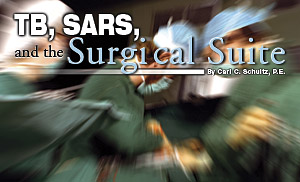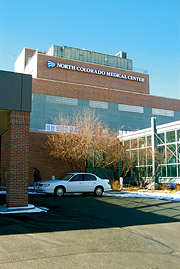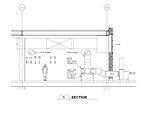

In the late 19th century, TB killed one out of every seven people living in the United States and Europe. TB remains a threat to the health and well-being of people around the world. Among infectious diseases, TB remains the second leading killer of adults in the world, with more than 2 million TB-related deaths each year.
SARS, or severe acute respiratory syndrome, emerged in China in November 2002 and quickly spread across the globe in a matter of weeks, eventually causing over 900 deaths. These realities place the design professional in a critical role in addressing the changes that need to be made in the layout and performance of the hospital environment to contain the spread of airborne infectious disease. URS Corporation found itself in this situation recently when designing an addition to North Colorado Medical Center (NCMC).
Commitment To A Community
The NCMC is located in Greeley, CO, which is situated approximately 60 miles north of Denver in Weld County, Colorado's leading producer of cattle and grain. The county attracts a large population of migrant workers from Mexico, which is medically underserved and, as a result, has a high prevalence of TB. Consequently, Weld County has a high number of persons with TB and NCMC receives these cases as well as referrals from surrounding areas.NCMC takes this responsibility seriously and has constructed a large number of isolation rooms to deal with active cases of TB. NCMC is currently undergoing a large expansion project that will add roughly 300,000 sq ft to its campus. This project includes eight isolation rooms plus 15 operating rooms and numerous support areas. During the planning phase, it was made clear that the ability to operate on patients with airborne infectious diseases was desired.
The Guidelines for Design and Construction of Hospital and Healthcare Facilities published by the American Institute of Architects (AIA) states that invasive procedures should not be performed on individuals with active TB in the operating suite, but rather in a room meeting airborne infection isolation ventilation requirements. The Centers for Disease Control and Prevention (CDC) has issued guidelines that require these isolation rooms be kept at a negative pressure to contain infectious agents. However, both AIA and ASHRAE recommend that operating rooms be kept under positive pressure in order to keep contaminants out of the operating room and away from the surgical site.
The current procedure at NCMC for operating on patients with active TB is to wait until after normal working hours when corridor traffic is limited and no other surgeries are scheduled. At that point, the surgery AHU is shut down to prevent contaminated air from being distributed to other parts of the hospital. After the surgery has been performed, the AHU remains off for approximately one hour to allow for the settling of airborne particles onto horizontal surfaces before the operating room is disinfected. After disinfecting, the AHU is restarted and the suite is ready for normal use the following day.
There are drawbacks to the approach of shutting down the ventilation system during a surgical procedure. An obvious problem is that surgeons prefer cold operating rooms. This cannot be achieved without plenty of conditioned air passing through the operating room removing the heat generated by surgical lights and other equipment. The lack of airflow across the patient will also thwart the attempt to maintain a sterile field at the surgical site. Additionally, this approach does not satisfy the AIA and ASHRAE guidelines for positive pressure in the operating room and for the introduction of fresh ventilation air.

Design Solution
The hospital staff had suggested solving the problem by designing a group of operating rooms that could be switched from positive pressure to negative pressure. Under normal conditions, the rooms would be subject to positive pressure and could be switched to negative pressure when a patient with active TB was scheduled to be operated upon. Although this solution solved the problem of containing the infectious agent, it posed two problems.First, both the AIA and ASHRAE guidelines as previously mentioned recommend positive pressure, not negative pressure for operating rooms. Second, the guidelines address the concept of switching rooms between positive and negative pressure by stating that "rooms with reversible airflow provisions for the purpose of switching between protective environment and AII (airborne infection isolation) functions are not acceptable."
The CDC's Guidelines for Preventing the Transmission of Mycobacterium Tuberculosis in Health Care Facilities states that "elective operative procedures on patients who have TB should be delayed until the patient is no longer infectious" and that "if operative procedures must be performed, they should be done, if possible, in operating rooms that have anterooms. For operating rooms without anterooms, the doors to the operating room should be closed, and the traffic into and out of the room should be minimal to reduce the frequency of opening and closing the door. Attempts should be made to perform the procedure at a time when other patients are not present in the operative suite and when a minimum number of personnel are present (e.g., at the end of the day)."
Considering this, it was decided that two dedicated operating rooms would be provided where surgery would be performed on patients with an airborne infectious disease. These rooms would have an anteroom to provide an air lock and would be clearly identified with signage as to their intended use. These operating rooms would have their own dedicated sub-sterile rooms and would be positive pressure with respect to their dedicated sub-sterile room and anteroom. The anterooms would be at a negative pressure with respect to the operating room and to the adjacent corridor providing directional airflow out of both the operating room and out of the corridor and into the anteroom. The door from the corridor into the anteroom and the door from the anteroom into the operating room would have directional airflow monitoring devices to indicate proper functioning of the ventilation systems (Figure 1).
Mechanical Systems
The addition of anterooms allows the operating room to be under positive pressure, allowing directional airflow out of the room, thereby keeping potential contaminants out of the room and away from the surgical site. This satisfies the AIA and ASHRAE guidelines for the positive pressurization of the operating rooms. The anteroom separates the corridor from the operating room and by setting it up as the most negatively pressurized space, it can then draw air in from both the operating room and the corridor. This prevents potentially contaminated air from getting to the corridor and into other parts of the hospital. This satisfies the CDC in creating a negative pressure zone to contain any hazardous agents.At the hospital's request, the concept of using ultraviolet germicidal irradiation (UVGI) was explored as a means to permit recirculation of air from the operating room back to the air-handling system when active TB cases were occurring. It should be noted that the CDC does not recommend this approach because this potentially contaminated air would be distributed to other areas of the hospital. The CDC states that "UV units installed in ducts should not be substituted for HEPA filters in ducts that discharge air from TB isolation rooms into the general ventilation system." Since surgery must be performed in rooms meeting infection isolation requirements, the only means allowing for recirculation is by way of HEPA filtration.
Although air is returned back to the air handlers serving the other operating rooms, the disposition of the air from the two surgery isolation rooms remained in question. It was decided that this air should be exhausted to the outdoors, even though the CDC allows recirculation if HEPA filtration is used and exhausting this airstream to the outdoors carries an energy penalty. Location of the HEPA units with this arrangement would be above ceilings near surgery, making accessibility difficult. Also, a filter leak through the media or around the frame would allow contaminated air to reach other areas of the building.
A more important factor is that the surgery AHUs would need to relieve a portion of the system air to the outdoors regardless in order to allow the introduction of fresh air to the space. Fresh air is important not only to replenish oxygen consumed by occupants, but to also dilute waste anesthetic gases generated in the operating rooms. The exhaust systems for the isolation operating rooms would then become a major relief air path for the entire surgery ventilation system.
Each surgery isolation room is served by an individual exhaust fan located on the roof as far as possible from the air handler intake louvers. The fans are utility sets selected for high static pressure and are fed from the emergency power system to ensure that the proper pressure relationships are maintained at all times. The exhaust ductwork is labeled as ‘"contaminated air" every 10 ft on its way up to the penthouse in accordance with CDC guidelines. The air then passes through a custom filter housing prior to entering the exhaust fan. In this way, the contaminated portion of the ductwork is under negative pressure, eliminating leaks out of the system.
At first it was debated whether to include HEPA filtration on the exhaust systems, as the fans would discharge a minimum of 7 ft above the roof level with the use of an exit stack. Prior isolation room exhaust system designs at the hospital included HEPA filtration, and this was expressed as a strong desire of the hospital staff. CDC guidelines do not require using HEPA filters on the exhaust stream from isolation rooms unless there is the potential for re-entrainment of exhaust back into the facility.
Differential pressure control was used to provide directional airflow to the anterooms instead of offset type control. Each of the two isolation surgery areas has a dedicated air terminal unit supplying air at a constant rate. A differential pressure controller senses the relative pressure between the operating room and the anteroom and sends a signal to modulate exhaust dampers to maintain the setpoint of 0.05 in. of water. There is an automatic damper in each of the two exhaust trunks serving each isolation operating room.
The differential pressure controller for each isolation operating room is mounted in the anteroom next to the door to the operating room. It displays the pressure differential and includes indicating lights that show normal and alarm conditions. The alarm condition is audible in surgery, and a signal is also sent to the BAS to notify the engineering staff of a problem. The BAS is also alarmed when the HEPA filter assembly reaches a pressure differential that indicates the filters are dirty.
The HEPA filter assemblies will become loaded with particulates over time, changing their resistance to airflow. The resulting increase in pressure drop must be compensated for, otherwise the exhaust flow rate would decrease, allowing the anterooms to approach neutral pressure or even go positive. To prevent this, a separate controller is used to maintain pressure in the exhaust duct upstream of the HEPA filter housing by modulating the speed of the exhaust fan through a VFD.

